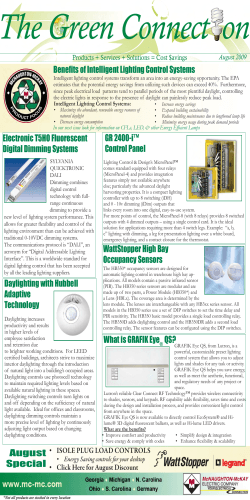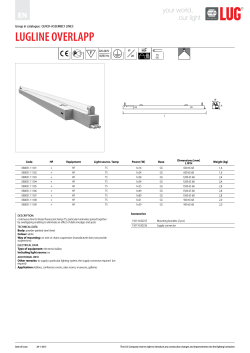
Smart Lighting ERC Feb 5 Agenda
Smart Spaces: Smart Lighting ERC Industry – Academia Days February 11 - 12, 2015 Agenda Wednesday, Feb. 11 Hilton Garden Inn, Troy, NY 7:30 am – 8:50 am Registration, Continental Breakfast and Networking 8:50 am – 9:00 am Welcome Address, , John Dordick, VP of Research, RPI 9:00 am – 9:15 am Smart Lighting, Trends, Opportunities and Challenges, Robert Karlicek, ERC Director and Professor, Electrical, Computer & Systems Engineering Dept., RPI 9:15 am – 9:30 am ERC Innovation and Industrial Collaboration Program, Silvia Mioc, ERC Director of Industrial Collaboration and Innovation, RPI and Dennis Bradley, IAB Chair and Manager, GE Lighting The presentation will give an overview of the various ways industry can interact with the ERC and the mechanisms in place to develop an entrepreneurial mindset in students. 9:30 am – 10:00 am Autonomous Lighting Controls, Richard Radke, ERC Controls Thrust Leader and Professor, Electrical, Computer & Systems Engineering Dept., RPI 10:00 am – 10:10 am Light Transport Analysis: Recovering Occupancy Distributions, Kim Boyer, Professor, Electrical, Computer & Systems Engineering Dept., RPI We adopt a computer vision inspired approach to interrogating a space to learn the spatial distribution of its occupants. The smart lighting objective is to adapt the intensity and spectral distribution of the lighting provided to the space to optimize energy consumption and the comfort, well-being, and productivity of its occupants. To do so requires knowledge of where people are in the space, and what their activities may be. In this presentation I will report our results using distributed inexpensive color sensors, rather than privacy-invasive cameras or other sensors, to infer high-level information, specifically the room occupancy distribution. Unlike a camera, a color sensor produces only a few numbers. However, if the lights in the room are color controllable, we can use the outputs of multiple color sensors under different lighting conditions to recover the room’s light transport model (LTM). As the room occupancy distribution changes, the LTM changes with it, and from that we can establish the mapping from LTM to occupancy distribution. 10:10 am – 10:40 am Break 10:40 am – 11:10 am Digitized Light for High Speed Wireless Communications, Tom Little, Associate ERC Director and Professor, Electrical & Computer Engineering Dept., BU 11:10 am – 11:40 pm Dynamic Optical Beam Control, Linda Schadler, Professor, Electrical, Computer & Systems Engineering Dept., RPI This talk will discuss the ERC’s latest plans for dynamic optical control, including scalable photonic crystal processing, flexible materials that provide a means for beam steering, and materials for dynamic refractive index control. The development of these new materials will allow rethinking the systems-level design, for example, creating 6" X 6" panels of light with LEDs on the edges and the ability to mix and shape the light output through both intrinsic and extrinsic controls. An update on the projects that have lead the center to address these problems, including electro-wetting experiments, beam steering via MEMS, assembly of dies, and index of refraction / color converting encapsulants, will also be provided. 11:40 pm – 12:10 pm Student Perfect Pitch Showcase: Finalists to present their research in 90 seconds 12:10 pm – 1:30 pm Lunch 1:30 pm – 2:00 pm Plenoptic Sensor for Smart Lighting Applications, Payman Zarkesh-Ha, Associate Professor, Electrical & Computer Engineering Dept., UNM The advent of LED lighting systems with large color gamuts, composed of 5- to 10-LEDs at different colors, offers the potential of increased lighting efficiency (lowered quantum defect losses), improved human health and productivity, and visible light communications to address the explosive growth in digital communications. A plenoptic sensor, providing spectral, angle of arrival and polarization resolution is required to realize these potentials. To be viable, the sensor has to be inexpensive, fully integrated with sensor electronics, has to have a low profile, and can have no moving parts. Conventional color cameras using dyes to provide a typical 100- to 200-nm color discrimination, matching the human visual system, do not have the required wavelength resolution nor out-of-band rejection and are angularly insensitive. Plasmonic structures also have been investigated to provide similar functionality, but also suffer from high losses and low resolution as a result of the non-ideal metal dielectric properties across the visible spectrum. A CMOS-compatible, visible, plenoptic (angle, polarization and wavelength) detector, based on a grating-coupled waveguide structure, is successfully demonstrated with an angular resolution of < 1° and a corresponding wavelength resolution of < 5 nm. More detail simulations and waveguide fabrications is underway. This project is a collaborative effort, where the simulation is performed at Boston University and the fabrication process is done at the University of New Mexico 2:00 pm – 2:10 pm Biohazard Detection: Ultra-wide Dynamic Range UV Sensors, Shayla Sawyer, Assistant Professor, Electrical, Computer & Systems Engineering Dept., RPI The role of this project is to investigate the detection of biohazards within a living space using the advantages of an LED light source coupled with detectors. Every space in which human health is of primary concern including offices, hospital rooms, and homes, is a potential environment to detect and mitigate hazards in a smart room. The system requires sensitive detectors able to measure fluorescence signals on the order of nW/cm2 in ambient light and at a distance. Using frequency modulation, which pulses the source LED at a specific frequency, commercial sensors coupled to that frequency were able to sense 340 nm fluorescence from a high concentration of microbes to 4.8 ft. in ambient light (8.0 ft. in a dark room). With use of ultra-wide dynamic range UV sensors (highest responsivity reported to date) and the frequency modulation technique, both the detection distance and sensitivity in ambient light will improve significantly. 2:10 pm – 2:40 pm Light Based Circadian Rhythm Regulation for Human Health, John Wen, Professor, Electrical & Computer Systems Engineering Dept., RPI 2:40 pm – 2:50 pm Lighting and Sleep, Lee Brown, Professor of Medicine and Director, University of New Mexico Center for Sleep Medicine 2:50 pm – 3:00 pm From spaceflight lighting to the patient bedside, George Brainard, Professor, Department of Neurology, Thomas Jefferson University 3:00 pm – 3:10 pm The Bright and Controllable Future of Horticultural Lighting, Tessa Pocock, Research Scientist, Smart Lighting ERC, RPI Modern horticultural growth facilities are automated with the use of robots and environmental sensors and control systems. However the sensing and control of the standard high pressure sodium fixtures is still quite rudimentary. Solid state lighting presents an opportunity to take control and automate the light environment in order to regulate plant growth and metabolism. An overview of the state of lighting systems in horticulture with a view to the future will be presented. 3:10 pm –3:20 pm ERC Educational program, Ken Connor, Director of Education and Professor, Electrical, Computer & Systems Engineering Dept., RPI 3:20 pm – 3:30 pm Elevator Pitch Competition Winner Announcement Page 2 3:30 pm – 3:45 pm 3:45 pm – 4:45 pm 4:45 pm – 5:45 pm 5:45 pm – 5:55 pm 5:55 pm – 6:00 pm Break Poster Session I: Odd Numbers Poster Session II: Even Numbers Proceed to Dinner Introduction: Robert Karlicek, ERC Director and Professor, Electrical, Computer & Systems Engineering Dept., RPI 6:00 pm – 6:30 pm Dinner Keynote: Shirley Cole, CREE Canada, President 6:30 pm Dinner Thursday, Feb. 12 RPI, Low Center of Innovation, 7th floor, Suite 7015, Troy, NY 8:30 am – 10:30 am Laboratory Tours Autonomous Controls and Visible Light Communications Testbeds and Demos For updates: http://smartlighting.rpi.edu/events/smart-spaces-2014.shtml or Silvia Mioc, [email protected] Page 3
© Copyright 2026












